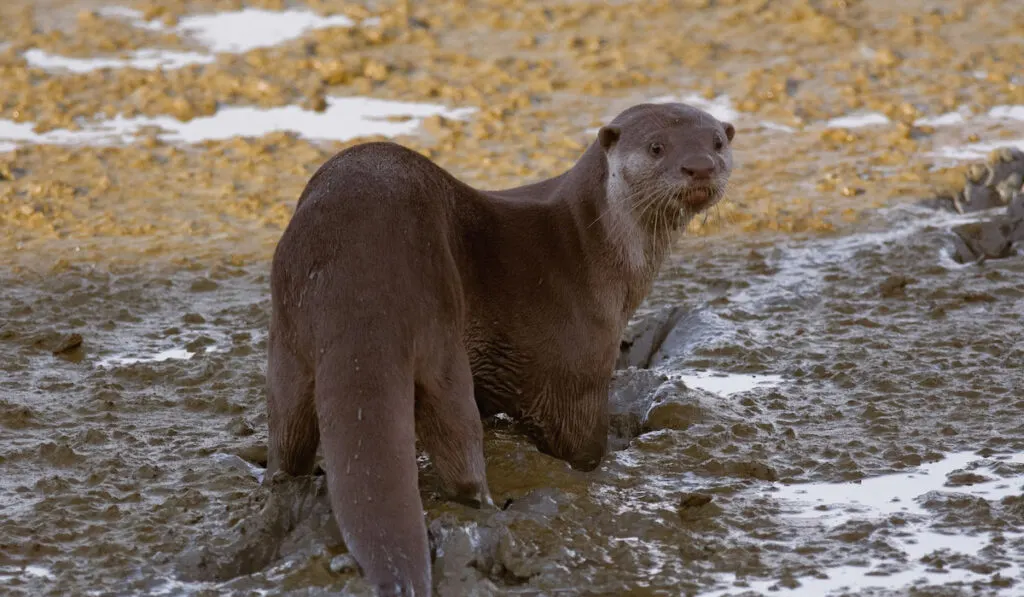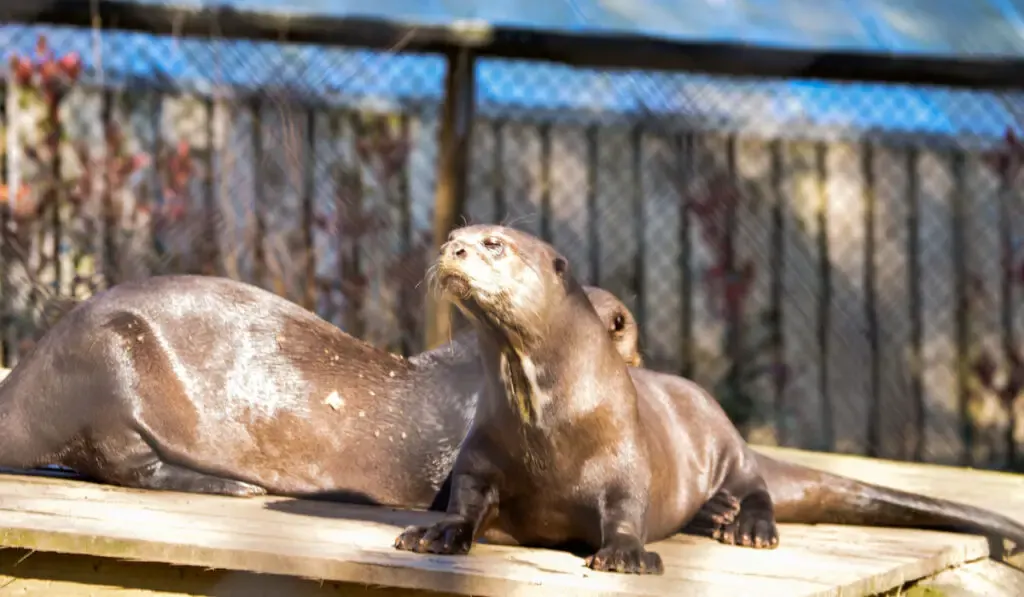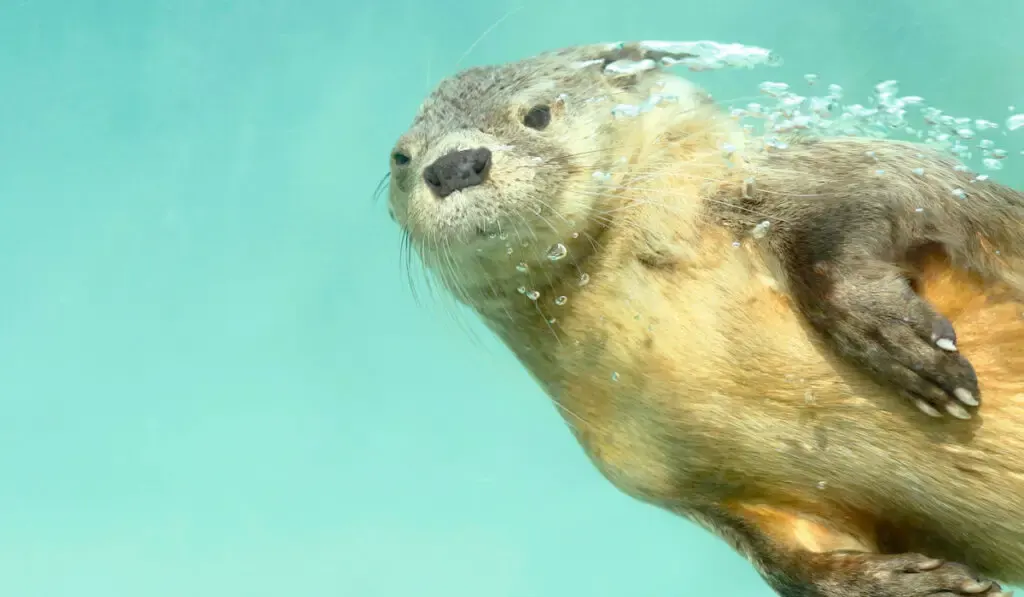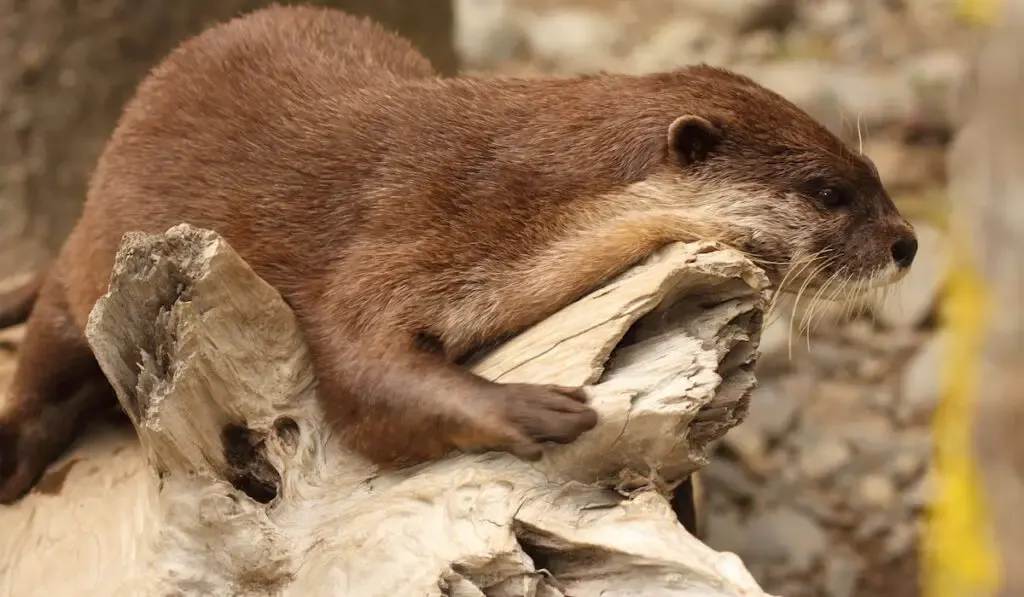Perhaps one of the most adorable mammals in the world, the otter is part of the weasel family. Otters have long slim bodies, elongated tails, with short ears and noses.
There are 13 existing species and can be found in every continent excluding Australia and Antarctica.
Of all animals, otters have the densest fur. Their webbed feet and strong tails allow otters to be good swimmers.
They are also known for having stinky poop, called “spraints”, which is known to come from the seafood they eat.

One remarkable behavior of the otter, particularly the sea otter, is the way it sleeps. It wraps itself in kelp so it doesn’t float away. Sometimes, it also hangs on with other sea otters by intertwining its feet with them.
Otters are unique and interesting animals that come in a number of different species.
In this article, we will take a closer look at 13 types of otters.
| Type of Otter | Where They Live | Freshwater/Saltwater |
| Eurasian Otter | Waterways and coasts of Europe, many parts of Asia, and parts of northern Africa | Freshwater and Saltwater |
| Smooth-coated Otter | Indian subcontinent, Southeast Asia | Freshwater |
| Asian small-clawed Otter | South Asia, Southeast Asia | Freshwater |
| Hairy-nosed Otter | Southeast Asia | Freshwater |
| Sea Otter | Coasts of the northern and eastern North Pacific Ocean | Saltwater |
| North American River Otter | North American continent | Freshwater and Saltwater |
| Neotropical Otter | Central America, South America, island of Trinidad | Freshwater |
| Giant Otter | Along the Amazon River, Pantanal | Freshwater |
| Southern River Otter | Chile, Argentina | Freshwater and Saltwater |
| Marine Otter | Littoral zones of southwestern South America, intertidal areas of northern Peru, the entire coast of Chile, the southern reaches of Argentina | Saltwater |
| African Clawless Otter | Sub-Saharan Africa, except for the Congo River basin and arid zones | Freshwater |
| Congo Clawless Otter | Mid-part of Africa | Freshwater and Saltwater |
| Spotted-Necked Otter | Sub-Saharan Africa | Freshwater |
Table of Contents
13 Types of Otters
1. Eurasian Otter (Lutra lutra)

Out of all otter types, the Eurasian Otter is the most widely distributed and has the largest geographical range. It primarily lives in lakes, rivers, and rocky coasts.
Eurasian Otters are usually 22.5-37.5 inches long with a tail length of 14-17.5 inches.
Their weight ranges from 15-26 pounds, although a large old male may weigh up to 37 pounds.
For the Eurasian Otters, the gestation period is around 60-64 days, after which one to four pups are born.
This species usually feeds on fish, although during winter they eat other foods such as insects, birds, frogs, and small mammals.
2. Smooth-Coated Otter (Lutrogale perspicillata)

Smooth-coated otters are found in rivers, estuaries, swamps, lakes, and rice paddies where fresh water is abundant.
As the name suggests, this species has shorter, smoother fur compared to other otter types.
It is a large otter with a head-body length of 23-25 inches, and a tail length of 15-17 inches. Its weight is 15-24 pounds.
The gestation period is 60-63 days with a litter size of up to five.
Smooth-coated otters primarily feed on fish, but they also eat rats, snakes, shellfish, amphibians, and insects.
3. Asian Small-Clawed Otter (Aonyx cinereus)

The smallest of all otter types, the Asian small-clawed otter is commonly found on mangrove swamps, small streams, and marshy areas.
Its head-body length is 18.4-24 inches with a tail length of 10.2-13.6 inches . Its weight ranges from 6-7.7 pounds.
The gestation period lasts for 62-86 days in which one to seven pups are born.
It mainly feeds on crabs, mudskippers, mollusks, and other bottom-living organisms.
4. Hairy-Nosed Otter (Lutra sumatrana)

The rarest and least known otter species, the hairy-nosed otter inhabits flooded forest, coastal mangrove, Melaleuca forest, marshland, and forest streams.
Its head-body length varies from 22.6-32.5 inches with a tail length of 13.8-20 inches. Its weight is usually between 11-18 pounds.
The gestation period is believed to be around two months, with one to four pups.
It usually feeds on fish, crabs, water snakes, mollusks, and crustaceans.
5. Sea Otter

The heaviest member of the weasel family, the sea otter is found on different marine coastal habitats, such as rocky shores, sea bottoms, and coastal wetlands where it dives and searches for food.
The sea otter is among the smallest marine mammal species, yet the heaviest mustelid. Its length ranges from 39-59 inches with a weight of 31-99 pounds.
Their gestation period lasts from 4-12 months with typical production of a single pup.
The Sea Otter is the only marine mammal that can lift and turn over rocks.
As it searches for food, the Sea Otter dives on the seafloor. Its diet includes abalone, crabs, starfish, clams, snails, and fish.
6. North American River Otter (Lontra canadensis)

The North American River Otter is commonly found near rivers, lakes, coastal marshes, and rocky seacoasts.
Its head-body length is 26-42 inches with a tail length of 12-20 inches. Their weight varies from 11-31 pounds.
The gestation period for North American River Otters appears to be 61-63 days with a litter size of one to three but can reach up to five.
It usually feeds on fish, but it also eats mussels, birds, crabs, amphibians, crayfish, rodents, frogs, and aquatic insects.
7. Neotropical Otter (Lontra longicaudis)

The Neotropical Otter usually settles in swamp forests and lowland rivers.
This otter has a body-length of 14-26 inches and a tail length of 15-33 inches. Its weight ranges from 11 to 33 pounds.
The gestation period lasts for 56 days with a litter size of one to five pups.
The Neotropical Otter primarily feeds on fish and crustaceans, but it will also sometimes eat mollusks and small mammals.
8. Giant Otter (Pteronura brasiliensis)

The longest member of the weasel family, the giant otter is found on rivers, streams, springs, and permanent freshwater lakes.
Out of all otter species, the giant otter is also the noisiest.
From head to tail, the length of this otter varies from 39.6-67.2 inches with weight ranging from 49-71 pounds.
On average, the gestation period of a female Giant Otter is 65-70 days, with one to five pups.
This otter type feeds mainly on fish, although it can also eat crabs and snakes if fish is not available.
9. Southern River Otter (Lontra provocax)
Despite its name, the southern river otter lives on both marine and freshwater environments. It inhabits lakes, rivers, and streams, usually along the shorelines.
It is a medium-sized species with an average head-body length of 30 inches and a tail length of 16 inches. Its weight is typically 11-22 pounds.
The gestation period of Southern River Otter is approximately two months, after which one to four pups are born.
It feeds on fish, crustaceans, birds, and mollusks.
10. Marine Otter (Lontra felina)

The marine otter is a rare type that inhabits rocky shorelines with abundant seaweed and kelp.
Its head-body length is 22-31 inches with a tail length of 12-14 inches. The gestation period is 60-70 days with a litter size of two to five pups.
The marine otter’s diet is varied, but it mostly feeds on crabs, mollusks, and bottom-living organisms.
11. African Clawless Otter (Aonyx capensis)

The second-largest freshwater otter, the African clawless otter is commonly seen on rivers, lakes, estuaries, mangroves, forests, and savannah.
The length of this otter, including the tail, is 45-64 inches. They usually weigh between 22-80 pounds.
Female African clawless otters gives birth to two to five pups after a gestation period of two months.
This otter type primarily feeds on crabs, fish, worms, and frogs.
12. Congo Clawless Otter (Aonyx congicus)
This large otter is the most terrestrial otter type, spending more time on land than the others. The Congo clawless otter inhabits marshes and shallow margins of lakes.
The head-body length is 24-39 inches with a tail length of 16-28 inches.
There is very limited information about the reproduction of Congo clawless otter. It is said that the gestation period is two months with an average litter of three to four pups.
Its diet includes soft prey animals, such as frogs, eggs, earthworms, freshwater crabs, mud dwelling fish, and small land vertebrates.
13. Spotted-Necked Otter (Hydrictis maculicollis)

The spotted-necked otter primarily lives on deep waters such as large lakes and rivers where they dive to forage for food.
It is a small otter type, measuring 28-30 inches from head to body. The tail length is 15-17 inches, with a weight of 6.6-14 pounds.
The gestation period is approximately two months, with a litter size of up to three pups. Part of its diet includes fish, amphibians, and crustaceans.
Sadly, all 13 otter types are in the Red Line of Threatened Species. They area all declining in numbers except the North American River Otter.
Some of the threats that otters are currently facing are pollution, habitat loss, human disturbance, trapping, competition with fisheries, roads, and illegal trades.
Although there are existing regulations designed specifically to protect otters, it is essential to start caring for our environment in order to help in their recovery.
References
- https://www.otter.org/public/OtterMap.aspx#
- https://www.nationalgeographic.com/animals/mammals/group/otters/#
- https://www.wwfindia.org/about_wwf/priority_species/threatened_species/smooth_coated_otter/
- https://www.georgiaaquarium.org/animal/asian-small-clawed-otter/
- https://www.discoverwildlife.com/animal-facts/mammals/otters-of-the-world/
- https://oceanconservancy.org/blog/2019/01/30/tell-difference-sea-otters-river-otters/
- https://www.livescience.com/55090-otter-facts.html
- https://en.wikipedia.org/wiki/North_American_river_otter
- https://en.wikipedia.org/wiki/Neotropical_otter
- https://en.wikipedia.org/wiki/Giant_otter
- http://www.conservenature.org/learn_about_wildlife/otters/southern_river_otter.htm
- https://en.wikipedia.org/wiki/Marine_otter
- https://en.wikipedia.org/wiki/African_clawless_otter
- https://www.mpalalive.org/field_guide/clawless_otter
- https://study.com/academy/lesson/spotted-necked-otter-habitat-diet-lifespan-facts.html
- https://en.wikipedia.org/wiki/Eurasian_otter
- https://en.wikipedia.org/wiki/Smooth-coated_otter
- https://en.wikipedia.org/wiki/Asian_small-clawed_otter
- https://en.wikipedia.org/wiki/Hairy-nosed_otter
- https://www.seaotters.com/sea-otter-natural-history/
- https://en.wikipedia.org/wiki/Sea_otter
- https://en.wikipedia.org/wiki/Southern_river_otter
- https://en.wikipedia.org/wiki/Congo_clawless_otter

